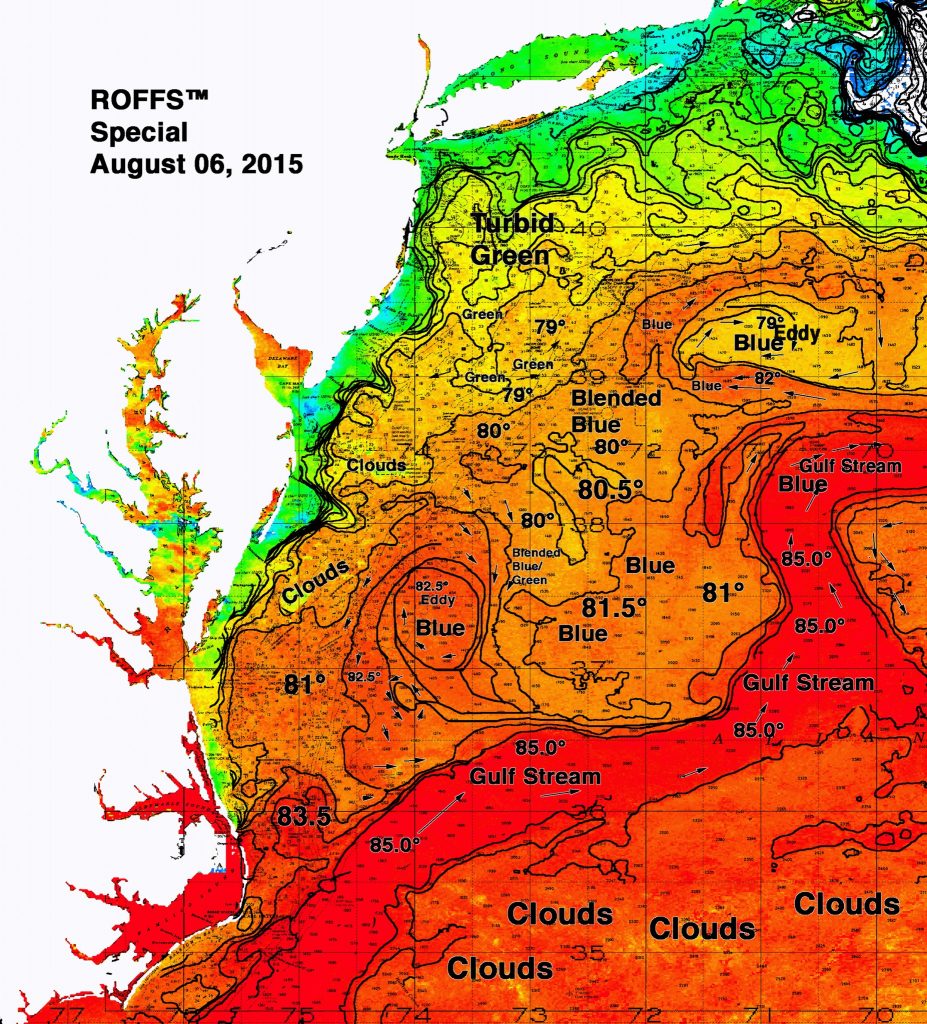ROFFER’S OCEAN FISHING FORECASTING SERVICE, INC.
TOLL FREE 800 677-7633 & (321) 723-5759 // EMAIL: fish7@roffs.com
ROFFS™ FISHERIES OCEANOGRAPHIC ANALYSIS
SPECIAL REGIONAL ANALYSIS FOR CAPE HATTERAS TO ATLANTIS CANYON (LAT./LONG.)
UPDATED ON THURS. 06 AUG. 2015 FOR THURS. P.M. AND FRI. FISHING ONLY
We are providing this regional update from today’s infrared and Wednesday and Tuesday’s combined ocean color image. The estimated early morning sst of the Gulf Stream is 85.0°F and continues eastward from Cape Hatteras until it is turned north by a counter-clockwise eddy centered near 69°30’W & 37°30’N (east of this image area). Near 39°30’N it turns eastward. Northwest of this turn is a blue water, clockwise rotating Gulf Stream eddy that has moved westward over the last few days. We anticipate that this eddy will reform with a center near 71°30’-15’W & 39°15’N over the next several days. This eddy continues to pull blue blended Gulf Stream water and fish over the mouth of the Hudson Canyon where good fishing action with bigeye tuna has continued this week. It is very likely that the new infusion of Gulf Stream water will be in marlin, wahoo, and mahi.
There is a substantial pool of turbid green and green water extending southward from western Long Island and northern New Jersey. This turbid water has been responsible for reducing the fishing action as the visually feeding tuna, wahoo, marlin, and mahi appear to be avoiding it and has moved over the Toms Canyon area. A “dirty” blend of this water extends south over the Carteret Canyon to the Wilmington Canyon. By the time it reaches Wilmington Canyon it has lost much of its turbidity and appears as a blue-green color.
The other clockwise rotating eddy over the Poor Mans Canyon and Washington Canyon areas continues to pull the blue-green water southward over the Wilmington Canyon and southward toward the Gulf Stream. Some of this water is likely to be pulled around the eddy over the next several days. A blend of this water is moving over the Baltimore Canyon. Bigeye tuna continue to be caught by over the Wilmington Canyon and Baltimore Canyon, particularly by fishermen fishing during the night and at last light and first light of the day. Marlin, yellowfin tuna and mahi fishing action has been slow.
Due either to the clouds or the blending water, we continue to have difficulty outlining the Gulf Stream eddy, but using a combination of sst and ocean color, along with on-site reports (thank you) we believe we have captured its essence. The eddy appears to have a morning sst of 82.5°F the same sst as the band of blue water that extends from the 300-600 fathoms of the Poor Mans Canyon to the Washington Canyon and over the Norfolk Canyon. This band is a mixture of the previous blue water that has existed over this area for the last month, as well as, some eddy water. While the current along the northern side of the eddy is eastward and between the Baltimore Canyon and Poor Mans Canyon east-northeastward. However, from the Rock Piles south to the Norfolk Canyon the current is moving southward.
The fishing action the last few days has been associated with the boundaries of the eddy and with the band of water extending now from the Poor Mans Canyon south. Some fishing action continues just north of the Poor Mans Canyon in the remnant eddy – blended Gulf Stream water.
There is a filament of blue cooler (81.5°F) water moving northward along the southwest side of the eddy. In a few days this is likely to circle the eddy and provide a better thermal outline.
Bottom Line: The best chances for fishing action continues to associated with blue water over the Hudson Canyon and particularly over the Poor Mans Canyon area.
Please click here to download FULL analysis as PDF.







